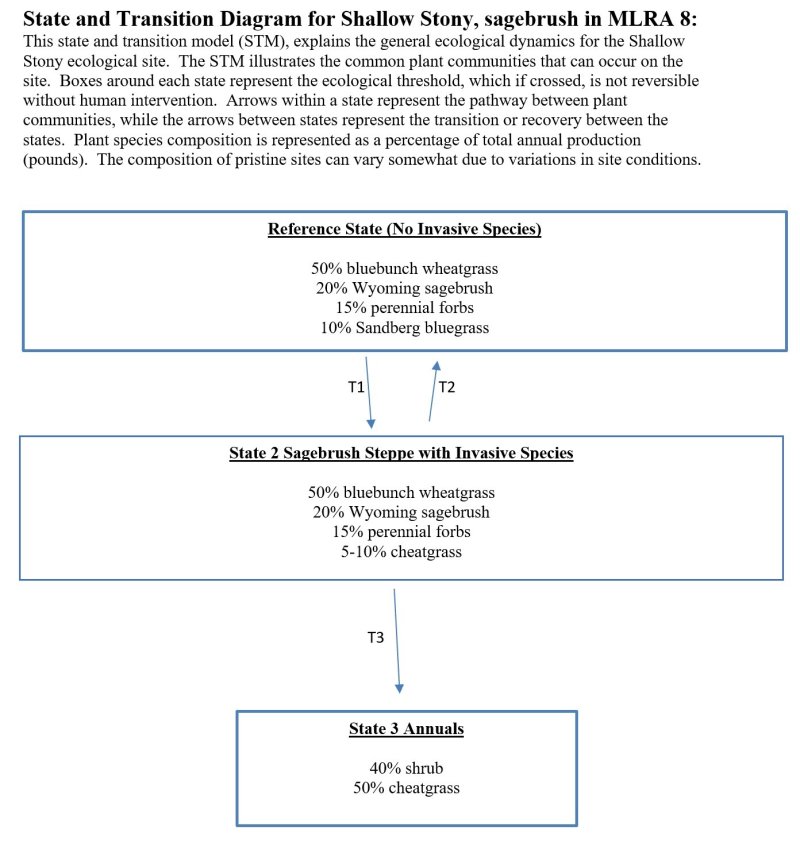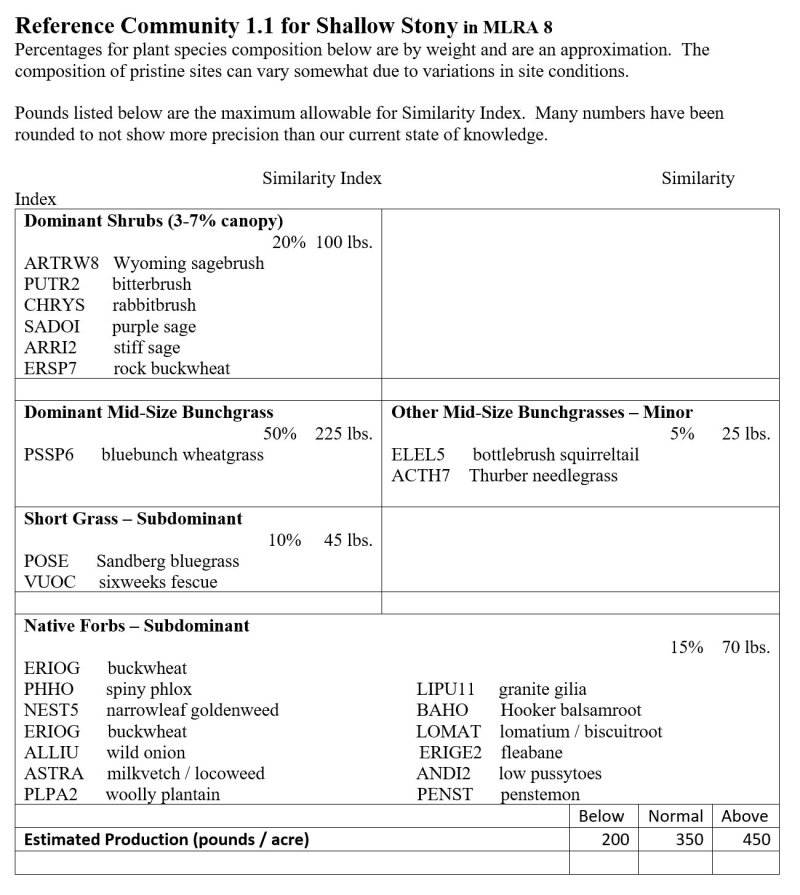Ecological site group R008XG112WA
Shallow Stony, Sagebrush
Last updated: 09/21/2023
Accessed: 01/15/2025
Ecological site group description
Key Characteristics
None specified
Provisional. A provisional ecological site description has undergone quality control and quality assurance review. It contains a working state and transition model and enough information to identify the ecological site.
Physiography
Hierarchical Classification
Major Land Resource Area (MLRA): 8 – Columbia Plateau
LRU – Common Resource Areas (CRA):
8.1 - Channeled Scablands
8.2 - Loess Islands
8.3 - Okanogan Drift Hills
8.4 - Moist Pleistocene Lake Basins
8.5 - Moist Yakima Folds
8.6 - Lower Snake and Clearwater Canyons
8.7 - Okanogan Valley
Site Concept Narrative:
Note: for MLRA 8 there are two ecological sites with the name “Shallow Stony’:
1. One for the sagebrush steppe region
2. One for grasslands on south side of Columbia Hills
The Shallow Stony ESD below is for the sagebrush region.
Diagnostics:
Shallow Stony is a sparsely vegetated upland site in the sagebrush steppe areas of MLRA 8 occurring on soils that are both shallow (10-20” deep) and stony to extremely stony. Soils have a stony or cobbly surface and rock fragments (35% or more) throughout the profile. Soil textures loam, silt loam, clay loam and clay are most common. The soil surface is mostly bare soil, soil biotic crust or rock.
Plants on Shallow Stony are widely scattered. Fire-sensitive shrubs dominate the reference state overstory, while perennial bunchgrasses and forbs provide the understory. The shrub layer is typically 18”-24” high Wyoming sagebrush. Cool-season bunchgrasses form two distinct layers. Bluebunch wheatgrass is the dominant bunchgrass in the top grass layer, while Sandberg bluegrass is the major grass of the lower grass layer.
Principle Vegetative Drivers:
The soil depth and stones throughout the profile drive the vegetative expression of this site. The shallow soil depth limits rooting, while the soil depth and stones limit the water holding capacity in the profile. Thus, plant production is quite limited for Shallow Stony sites.
Influencing Water Features:
A plant’s ability to grow on a site and overall plant production is determined by soil-water-plant relationships:
1. Whether rain and melting snow runs off-site or infiltrates into the soil
2. Whether soil condition remain aerobic or become saturated and become anaerobic
3. Water drainage and how quickly the soil reaches wilting point
With adequate cover of live plants and litter, there are no restrictions on this ecological site with water infiltrating into the soil. In some years Shallow Stony sites can become saturated due to the shallow soil depth, but with good drainage would remain anaerobic for only a short period of time. This site has an extremely restricted water holding capacity, so plant production is quite limited.
Physiographic Features:
The landscape is part of the Columbia basalt plateau. Shallow Stony sites occur on sideslopes of ridges and plateaus, ridges & benches, footslopes and hillslopes, and canyon walls.
Physiographic Division: Intermontane Plateau
Physiographic Province: Columbia Plateau
Physiographic Sections: Walla Walla Plateau Section
Landscapes: Hills, valley, channel scablands and plateaus
Landform: Sideslopes, terraces, alluvial fans, nose slopes
Elevation: Dominantly 600 to 4,000 feet
Slope: Total range: 0 to 65 percent
Central tendency: 2 to 35 percent
Aspect: Occurs on all aspects
Geology:
This MLRA is almost entirely underlain by Miocene basalt flows. Columbia River basalt is covered in many areas with as much as 200 feet of loess and volcanic ash. Small areas of sandstones, siltstones, and conglomerates of the Upper Tertiary Ellensburg Formation are along the western edge of this area. Some Quaternary glacial drift covers the northern edge of the basalt flows, and some Miocene-Pliocene continental sedimentary deposits occur south of the Columbia River, in Oregon.
A wide expanse of scablands in the eastern portion of this MLRA, in Washington, was deeply dissected about 16,000 years ago, when an ice dam that formed ancient glacial Lake Missoula was breached several times, creating catastrophic floods. The geology of the northernmost part of this MLRA is distinctly different from that of the rest of the area. Alluvium, glacial outwash, and glacial drift fill the valley floor of the Okanogan River and the side valleys of tributary streams. The fault parallel with the valley separates pre-Tertiary metamorphic rocks on the west, in the Cascades, from older, pre-Cretaceous metamorphic rocks on the east, in the Northern Rocky Mountains. Mesozoic and Paleozoic sedimentary rocks cover the metamorphic rocks for most of the length of the valley on the west.
Climate
The Wyoming sagebrush-bluebunch wheatgrass areas are both warmer and drier than grasslands or other shrub steppe sites (Daubenmire). The climate is characterized by moderately cold, wet winters, and hot, dry summers, with limited precipitation due to the rain shadow effect of the Cascades. Taxonomic soil climate is either xeric (12 – 16 inches PPT) or aridic moisture regimes (10 – 12 inches PPT) with a mesic temperature regime.
Mean Annual Precipitation:
Range: 10 – 16 inches
Seventy to seventy-five percent of the precipitation comes late October through March as a mixture of rain and snow. June through early October is mostly dry.
Mean Annual Air Temperature:
Range: 44 to 54 F
Central Tendency: 48 – 52 F
Freezing temperatures generally occur from late-October through early-April. Temperature extremes are 0 degrees in winter and 110 degrees in summer. Winter fog is variable and often quite localized, as the fog settles on some areas but not others.
Frost-free Period (days):
Total range: 90 to 210
Central tendency: 120 to 160
The growing season for Shallow Stony is March through June.
Soil features
Edaphic:
The Shallow Stony ecological site commonly occurs with Stony, Loamy, Very Shallow, Cool Loamy and Loamy Bottom ecological sites.
Representative Soil Features:
This ecological site components are dominantly Lithic, Aridic and Argiduridic taxonomic subgroups of Haploxerolls, Durixerolls and Argixerolls great groups of the Mollisols taxonomic order, with Aridisols occurring as well. Soils are dominantly shallow. Average available water capacity of about 5.0 inches (12.7 cm) in the 0 to 40 inches (0-100 cm) depth range.
Soil parent material is dominantly mixed loess, colluvium and residuum, with mixed ash possible.
The associated soils are Camaspatch, Disage, Durtash, Fortyday, Horseflat, Lickskillet, Rock Creek, Starbuck, Vantage and similar soils.
Dominate soil surface is clay to very cobbly loam, with ashy modifier sometimes occurring as well.
Dominant particle-size class is clayey to loamy-skeletal
Fragments on surface horizon > 3 inches (% Volume):
Minimum: 0
Maximum: 5
Fragments within surface horizon > 3 inches (% Volume):
Minimum: 5
Maximum: 30
Average: 10
Fragments within surface horizon ≤ 3 inches (% Volume):
Minimum: 5
Maximum: 30
Average: 10
Subsurface fragments > 3 inches (% Volume):
Minimum: 10
Maximum: 40
Average: 20
Subsurface fragments ≤ 3 inches (% Volume):
Minimum: 15
Maximum: 45
Average: 25
Drainage Class: Dominantly well drained
Water table depth: Greater than 60 inches
Flooding:
Frequency: None
Ponding:
Frequency: None
Saturated Hydraulic Conductivity Class:
0 to 10 inches: Moderately high and moderately low
10 to 40 inches: Moderately high and moderately low
Depth to root-restricting feature (inches):
Minimum: 10
Maximum: 20
Electrical Conductivity (dS/m):
Minimum: 0
Maximum: 5
Sodium Absorption Ratio:
Minimum: 0
Maximum: 0
Calcium Carbonate Equivalent (percent):
Minimum: 0
Maximum: 5
Soil Reaction (pH) (1:1 Water):
0 - 10 inches: 5.6 to 9.0
10 - 40 inches: 6.1 to 9.0
Available Water Capacity (inches, 0 – 40 inches depth):
Minimum: 1.0
Maximum: 7.9
Average: 5.0
Vegetation dynamics
Ecological Dynamics:
Shallow Stony produces about 200-450 pounds/acre of biomass annually
Wyoming big sagebrush and bluebunch wheatgrass are at the core of the Shallow Stony ecological site and warrant a degree of understanding.
Wyoming sagebrush in a long-lived, multi-branched, evergreen shrub. Size is no more than 18” to two feet high on Shallow Stony. Wyoming big sagebrush has a significant rooting system, composed of a two-part rooting structure with a primary deep taproot, and a shallow extensive network of finer roots that spread laterally. This rooting system allows Wyoming big sagebrush to survive in the hottest and driest portions of the sagebrush range by tapping into groundwater sources deep into the soil profile itself. This also allows Wyoming big sagebrush to be more competitive with bunchgrasses when the landscape positions and/or soils are less ideal for grass species to maintain the competitive advantage.
Bluebunch wheatgrass is a long-lived, mid-sized bunchgrass with an awned or awnless seed head arranged in a spike. Bluebunch provides a crucial and extensive network of roots to fill the soil profile on Shallow Stony. These roots create a massive underground source to stabilize the soils, provide organic matter and nutrients inputs, and help maintain soil pore space for water infiltration and water retention in the soil profile. The extensive rooting system of mid-sized bunchgrasses leave very little soil niche space available for invasion by other species. This drought resistant root can compete with, and suppress, the spread of exotic weeds.
The stability and resiliency of the reference communities is directly linked to the health and vigor of bluebunch wheatgrass. As long as bluebunch wheatgrass plants occupy the site, the system holds together. If we lose the bluebunch the ecosystem crashes or unravels.
Shallow Stony is resistant to most natural disturbances and ecologically stable. Due to 35-75% surface rocks and limited forage, this ecological site is not attractive to grazing animals and so are rarely if ever grazed. The vegetative cover is too low to carry fire, so these sites rarely burn. Based on inherent protection from both fire and grazing, most Shallow Stony sites are stable.
In many pastures, However, if this site does experience a major disturbance it is not resilient and may be extremely difficult to stabilize once altered. For example, vehicle traffic when the soil is saturated will leave ruts that remain for years to come.
For sites that are grazed, as grazing pressure increases the plant community unravels in stages:
1. Bluebunch wheatgrass declines while sagebrush and buckwheat species increase
2. As bluebunch wheatgrass continues to decline, invasive species such as cheatgrass and knapweed colonize the site
3. Shallow Stony sites rarely have more than thinly scattered cheatgrass.
For more grazing management information refer to Range Technical Notes found in Section I Reference Lists of NRCS Field Office Technical Guide for Washington State.
In Washington, Wyoming sagebrush – bluebunch wheatgrass communities provide habitat for a variety of upland wildlife species.
Supporting Information:
Associated Sites:
Shallow Stony sagebrush is associated with other ecological sites in the sagebrush steppe areas of MLRA 8, including Stony, Loamy, Very Shallow and Cool Loamy.
Similar Sites:
Shallow Stony sagebrush in MLRA 8 Columbia Plateau is a sparsely vegetated Wyoming sagebrush – bluebunch wheatgrass ecological site. It lands between Very Shallow and deeper Wyoming sagebrush – bluebunch wheatgrass sites which are more productive.
MLRA 7 Columbia Basin Shallow Stony Sand, and MLRA 6 East Slope of the Cascades Shallow Stony 2800-4000 feet are also sparsely populated shrub-bluebunch wheatgrass site.
Inventory Data References (narrative):
Data to populate Reference Community came from several sources: (1) NRCS ecological sites from 2004, (2) Soil Conservation Service range sites from 1980s and 1990s, (3) Daubenmire’s habitat types, and (4) ecological systems from Natural Heritage Program
Major Land Resource Area
MLRA 008X
Columbia Plateau
Subclasses
Stage
Provisional
Contributors
Provisional Site Author: Kevin Guinn
Technical Team: K. Moseley, G. Fults, R. Fleenor, W. Keller, C. Smith, K. Bomberger, C. Gaines, K. Paup-Lefferts
Click on box and path labels to scroll to the respective text.

